2005 June
About Andrew Cusack
 Writer, web designer, etc.; born in New York; educated in Argentina, Scotland, and South Africa; now based in London.
Writer, web designer, etc.; born in New York; educated in Argentina, Scotland, and South Africa; now based in London. read more
News
Blogs
Reviews & Periodicals
Arts & Design
World
France
Mitteleuropa
Knickerbockers
Argentina
The Levant
Africa
Cape of Good Hope
Netherlands
Scandinavia
Québec
India
Muscovy
Germany
Academica
Shenorock
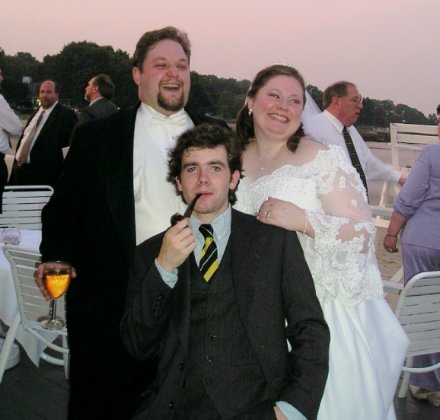
The more deductively inclined amongst you, dear readers, shall of course have extrapolated two conclusions from the above photograph. First, there has been a wedding. Second, I have obtained a pipe. Huzzahs all around.
I have known the young lady formerly known as Katie Lennon as long as I can remember, and I’ve known Brendan Daly more or less as long as they’ve been an item. The twain were joined in a happy and blessed union on Saturday afternoon at the Church of St. Joseph in Bronxville, and we all wish Mr. and Mrs. Brendan Daly a fruitful and happy marriage. The reception followed shortly afterwards at the Shenorock Shore Club on Milton Point in Rye, New York.
I had not really been to Shenorock in a number of years but many a day in the Cusack childhood was spent there, especially during the summers. We kids generally found it disagreeable while our parents found it an ideal place to unwind. Some summers my mother worked the 7:00pm to 7:00am shift at Lawrence Hospital in Bronxville. She would come home from work in the morning, wake my brother, sister, and I, pile us into the car, pick up the Lennon children and the McKegney children and head to Shenorock. We were kept busy at the club’s day camp while Mum slept on the beach for a five or six hours, read when awake, then collected us all again, dropped us off at our homes, fed us Cusacks dinner, and headed off to work.
For some reason I never liked going to Shenorock as a kid but nonetheless the place is a fountain of fond memories as I grow older. Just the other day a few of us were sitting in Scott Bennett’s back garden; Scott and I reminisced about summers at Shenorock, kickaboo juice, and crazy Mr. A (the summer camp’s director). Tommy Lennon (who’s my age, the younger brother to Mrs. Daly) and I would built forts and castles on the beach and man them with those little green plastic army men. Barbecues in the wooded Bowery were frequent, and of course the magnificent fireworks display for the Fourth of July was an annual obligation (who can forget the grand finale!). Strangely, we kids also had a pronounced hatred for Coveleigh, the neighboring club. (For some reason there was no similar disliking of the American Yacht Club, also on Milton Point on the other side of Shenorock). They were the France to our Germany and for some reason amongst us young’ins the rivalry was passionate. Of course now that I’m an old man Coveleigh’s bowling green grows more and more attractive.
Shenorock’s home on Milton Point is easily the most beautiful spot on the Westchester coast (only Red Bridge and Manor Park come close to challenging it). A seemingly permament breeze rolls off the Long Island Sound and keeps the Summer Clubhouse with its long, awninged deck overlooking the sandy strand at a comfortable temperature. The Winter Clubhouse across the street overlooks Milton Harbor and the dining room once afforded an excellent prospect of the Twin Towers all the way down in Manhattan. A happy place with happy memories.

The large beach in the center belongs to Shenorock, with the large summer clubhouse on it with flanking cabanas. The winter clubhouse and dock are on the other side of Milton Point, on Milton Harbor. Coveleigh is at the top right, and the American Yacht Club at the bottom left, covering the end of the point.
From Google Maps
And the pipe, dear reader? What a felicitous gift! It was a present from my old school friend Lev Trubkovich (aka Leviathan), who even chucked in some tobacco from Nat Sherman. The last time I had enjoyed the pleasures of the smoking pipe was deepest winter amongst our friends in New Haven. Places where we have smoked our pipe so far: on Red Bridge, watching the world (and the geese, and the swans) pass by; in my hammock in the back garden whilst reading; in Pelham enjoying the company of Nick Merrick, Panda, Simon (also called ‘Generalinnimo’ owing to his short stature), and Miss McGarry; and finally, planted in a deck chair at Shenorock on Saturday evening. We hope we shall find many more places to enjoy our pipe.
Calatrava’s St. John the Divine

I’ve always somewhat admired Santiago Calatrava’s plan for the completion of the (Episcopalian) Cathedral of St. John the Divine here in New York. It was commissioned in the 1980’s by the über-dodgy Rev. James Parks Morton, dean of the Cathedral at the time. Morton was responsible for turning “St. John the Unfinished” into the hippie-trippy-ecumenical-syncretist-pagan-temple-cum-performing-arts-center it is known as today, and came up with this scheme to try to bring the cathedral to completion. (The plan has since been abandoned and all construction ceased a decade ago; scaffolding remains because the cost of removing it was judged to be too high).

 The plan involved a ‘biosphere’ garden being planted atop the nave in the giant greenhouse formed by Calatrava’s lithely arches. Though I much prefer the crossing tower in the design by Ralph Adams Cram, I still think that Calatrava’s plan is rather exciting. It only succeeds, however, because Cram and (Heins & Lafarge before him) laid an ample beautiful foundation (well, obviously quite much more than that) for Calatrava to complete. The cathedrals which Signor Calatrava has designed completely himself have been completey devoid of aesthetic appeal, as well as conceived outside of the millenia-long tradition of church architecture.
The plan involved a ‘biosphere’ garden being planted atop the nave in the giant greenhouse formed by Calatrava’s lithely arches. Though I much prefer the crossing tower in the design by Ralph Adams Cram, I still think that Calatrava’s plan is rather exciting. It only succeeds, however, because Cram and (Heins & Lafarge before him) laid an ample beautiful foundation (well, obviously quite much more than that) for Calatrava to complete. The cathedrals which Signor Calatrava has designed completely himself have been completey devoid of aesthetic appeal, as well as conceived outside of the millenia-long tradition of church architecture.
The (Catholic) Diocese of Oakland commissioned Calatrava to design their new ‘Cathedral of Christ the Light’ after the old seat was greatly damaged in an earthquake. Despite the vacuousness of the design (model below), Signor Calatrava proved to be outside the Diocese’s budget, and his second-rate design was shelved and replaced with a third-rate design of a vaguely similar ilk. The third-rate design is the one which will be built, though a first-rate proposal in the vernacular style natural to California has been drawn up by Mr. Domiane Forte. Methinks Signor Calatrava should stick to his catchy bridges.

Brownson on the Scholar
Perhaps the Most Vile Sentence Ever Printed in Any Governmental Document in the Entire British Commonwealth of Nations
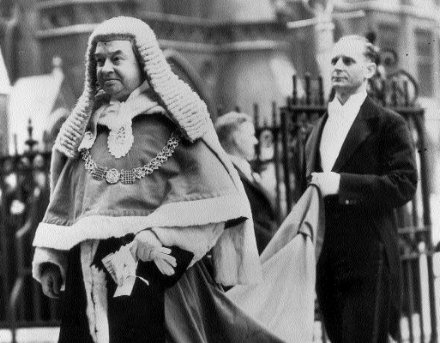
‘Court Working Dress in England and Wales’, May 2003
This sentence alone epitomises the noxious worldview of the modernist. It is a sentence that pronounces with totalitarian authority a ruling to which it allows no appeal. Tradition, they would tell us, has no inherent value in and of itself. It is nothing but a potential boon to the tourist industry – which is thoroughly reprehensible itself.
Yes, you heinous ignoramuses! There is a justification for retaining wigs and gowns in court on the grounds of tradition alone: thus it is, and ever thus it has been, and ne’er has a soul come to harm because of it! Fat, vile, impudent, ignorant modernist bureaucrats! I believe there is a tradition in the American South involving a self-appointed gang of citizens, a noose, and a tree with strong branches. I couldn’t think of a more appropriate exercise of such a tradition than ridding us of the damnable soul – loathsome, worthless degenerate! – who composed that sentence with all its odious implications.
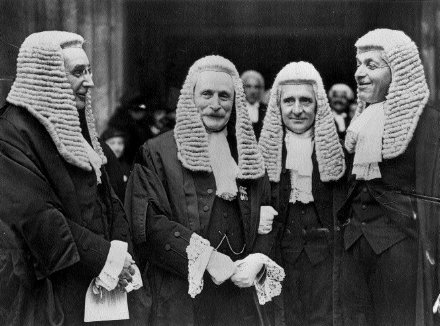
You may read the detestable ‘consultation paper’ online at what was the Lord Chancellor’s Department but which has since been corporately rebranded by Tony and the gang as the ‘Department for Constitutional Affairs’ with its own catchphrase ‘Justice, rights and democracy’ (sic), lacking the Oxford comma. There are further contemptible utterances in the document; it is not for the faint of heart.
St. Gregory’s, Brooklyn
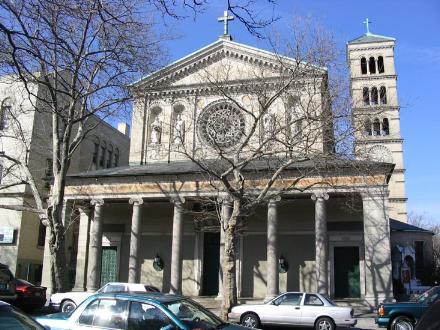
“St. Gregory’s Church of 1917, located at Brooklyn Avenue and St. John’s Place, was closely based on the ‘idealistic ground plan’ of St. Clement in Rome, an archetypal basilica with an open, colonnaded narthex and a tall engaged campanile on one side of the nave. In keeping with its prototype, St. Gregory’s was gaudily decorated with figural frescoes and mosaics.” – New York 1930
It seems a rather pulchritudinous church; I’ll have to add it to the list of places to visit. It was designed by Helmle and Corbett, who were also responsible for the Bush Tower, built a year later. The Bush Tower will soon get a brand new neighbor, seen below.

Top photo lifted from the ever-nifty Bridge and Tunnel Club‘s Walk Down Brooklyn Avenue.
Boldt Castle

Boldt Castle would have been among the finest homes in all New York had it ever been completed. The estate was started by Prussian immigrant and hotel entrepreneur George Boldt in the early 1900’s, and was intended to be presented to his wife Louise on St. Valentine’s Day. Tragically she died in 1904 before the castle was completed and work on the nearly-finished home stopped. The Boldts never returned to the island.
The small island estate is impressive nonetheless. It rests in the middle of the Saint Lawrence River on what was originally called Hemlock Island in the Thousand Islands region of New York. The island was renamed Hart Island when purchased by Congressman E.K. Hart, and upon being sold to the Boldts, the spelling was changed to Heart Island. (more…)
Rip van Winkle
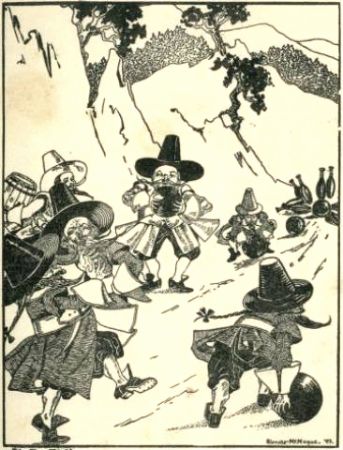
When was the last time you read the story of Rip van Winkle? If you’ve never had that pleasure, then you are all the worse for it, my friend. The tale was handed down to us through the ages by the munificence of one Diedrich Knickerbocker, though some sore-minded rapscallion later credited the ever-capable Washington Irving with its invention. Anyhow, it is one of my favorite tales in all the history of New York. It’s a short story, and worth a read online if you haven’t a printed copy immediately at hand.

The tale, of course, revolves around “a simple good-natured fellow”, namely Rip van Winkle, and his encounter with “odd-looking personages” whom still to this day show themselves around the Hudson valley. We merely have ceased to hear reports of them because thoroughly unimaginative types are in control of the world these days. (The “monotony monitors” as my Latin teacher monikered them, enforcing boredom and mediocrity at every possible opportunity).
The genealogists amongst you will be interested that Mr. Knickerbocker notes this van Winkle was “a descendant of the Van Winkles who figured so gallantly in the chivalrous days of Peter Stuyvesant, and accompanied him to the siege of Fort Christina.” Now, for want of fast-paced action, you may not have any particular desire to read about a simple, good-natured fellow like Rip van Winkle, but desires aside you must read “the Most Horrible Battle Ever Recorded in Poetry or Prose” (Chapter VII of Book VI of the same Diedrich Knickerbocker’s A history of New York, from the beginning of the world to the end of the Dutch Dynasty). The record of the siege of Swedish Fort Christina by the good New Netherlandish is the most hilarious and enchanting chronicle of any battle anywhere.
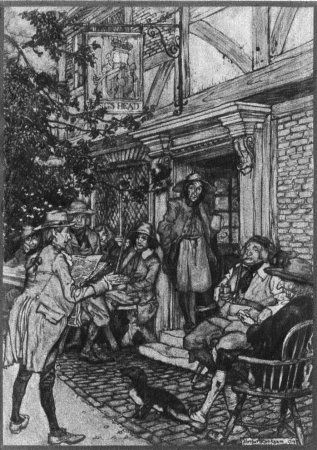
Behold, the Power of Myth
“Live 8 Hype Recalls Triumph of Live Aid” sounds forth the headline of a recent Associated Press article. Read the article, if you dare. It is exhibitive of the decline (or is it death?) of modern journalism. It is completely lacking in any inquisitive or challenging spirit and one would not be terribly foolish to mistake it for a press release of Live 8’s public relations department.
Now, arguably Live Aid may have been a triumph in the sense of it being a highly-sucessful rock concert, but as a humanitarian endeavour it was far from anything approaching a ‘triumph’. Much of the money raised, after all, merely lined the pockets of Ethiopia’s evil dictator Mengistu who, it should be recalled, pretty much started the famine in the first place. (A starving populace is much easier to control). Yet the only negative thing the article has to say is mentioning the few fumblings of the hastily-organised 1985 shindigs. The writer – ‘journalist’ if flattery is your wont – merely adopts a commonly-accepted myth and accepts it unreservedly as fact. Journalism? Balderdash!
A Note on St Andrews
St Andrews is, in many ways, a little oasis which we have been blessed with the pleasure of enjoying. Edinburgh is close enough to make journeying there feasibly, yet far enough to make it still a slight effort to go there. We have a library which, though not comparable to Alexandria of old nor Bodley’s or Congress’s of late, has a wide and deep breadth and enough to keep us occupied. We have beautiful beaches, divine strands on which to saunter, rest a while, exascerbate ourselves, paddle in the waves, or converse with a friend. We have a number of good bookshops in which to peruse ancient volumes. We have myriad cafés in which to read our books, and pubs in which to stir our minds over pints of bitter. We have a style of teaching which allows ample time to wander the library, ambulate down the sands, explore the booksellers, enjoy our drinks. We have, most thankfully, a community of orthodox Catholics and fellow travellers, saints and sinners, which provides sufficient good times and fellowship that one imagines we’d be happy even without our beaches, libraries, cafés, et cetera. We have an entire lifestyle of tradition, thought, worship, and enjoyment. It was ever thus, we are told, and ever thus it shall be, God willing.
Some Thoughts on Conservatism
I. Conservatism is an anti-ideological ideology. It is as uncomfortable being labelled an ideology, though it is, as secular humanism is uncomfortable being labelled a religion, though it is. Many have tried to precisely extrapolate the tenets of conservatism, most noticeably Russell Kirk in the last century, but I believe this to be a somewhat fruitless enterprise. To me, conservatism seems to be the prudent attempt to balance continuity with change, erring on the cautious side of the wisdom of our elders and ancestors rather than the fashions of our day. After all, tradition, according to Chesterton, is the democracy of the dead.
Conservatism – when I say conservatism I mean of course the real pragmatic traditional Christian social ideal, my conservatism, not neo- or corporate or libertarian or whatnot – gives voices to all the epochs of civilization and progresses along a merry path of continuity. Continuity is a keystone of conservatism. Falkland said “when it is not necessary to change, it is necessary not to change.” I’d be inclined to agree. The modern way of thought – ‘liberalism’, progressivism, socialism, what have you – insists on a break with the past: a chasm between what has always been and what they would have us be. It is revolution, instead of evolution. As science has shown us, evolution is how God has made Man what he is; revolution is how Satan perverts us from what we should be. Where there has been a breach between ourselves and the past, we must fill it. Not retreat to the other side of the gap, but fill it. Restore, inspire, and create; don’t retreat.
II. In a conservative world, the Church inspires John to give to Jack. This is virtuous. In a modernist world, the State takes from John, gives half to bureaucrats, and some to Jack. This is ridiculous.
III. America, by some curious fate, stands today as the paragon of conservatism. Many find this out of step with the founding of the United States, and I believe them mistaken in so finding. When we look at the British political tradition, we can see that in many ways the American Revolution, imprudent as it may have been, fits in perfectly with English political evolution: from Runnymede, to William and Mary, then Lexington and Concord, and finally Philadelphia 1789.
Ah, but perhaps I have fallen into the danger of constructing meta-narratives. The British political tradition also has its contradictions. The freedom of the Church was considered so utterly central and important that it was the first tenet of the Magna Carta, but was then so blatantly trampelled upon by Henry VIII and his succesors (excepting Mary I). Would the great Westminster system of government – which still today governs Britain, Canada, Australia, New Zealand, and of course India, the largest democracy the world has ever seen – have been possible had not the rupture between England and the rest of Christendom occurred? I believe so, others may disagree; arguments can be made either way. At the end of the day, the what-if game is not one to which we should devote much time.
Friends, Cousins, and Foreigners
During my various travels – which have been limited in comparison to those of others but I dare say very rich experiences nonetheless – I have sometimes been tempted into a system for the classification of people and peoples. There are friends, cousins, and foreigners.
Since I am an American, friends are Americans. American is a very open, wide, and varied category of person. A cabbie born in India, an accountant of Italian extraction, a stockbrocker with Irish origins, a factory worker who a few generations back is a Pole: all are Americans. A New Yorker, DCer, Virginian, a Kansan, Texan, Oklahoman, even a Californian: all are Americans.
As Americans, our cousins are varied. There are first the most obvious cousins: Brits, Canucks, Aussies, Kiwis, the Irish, and white Africans. They all might prefer their home countries, but don’t feel as if each others are quite foreign. I have lived in (or to be precisely, I currently spend most my time in) Britain and it doesn’t seem quite that foreign, though it certifiably isn’t home. I suspect (though cannot prove) this would be quite the same were I an American at Sydney, McGill, Otago, Trinity, or Rhodes instead of an American at St Andrews.
Let us therefore suppose the British, Australians, New Zealanders, Canadians, Irish, and white Africans are our first cousins. There are also other people, who seem foreign but I think would also be quite familiar to us. During my time in Argentina I discovered that the Argentine middle/upper class were entirely our cousins, not foreigners. They are also zealous Anglophiles. (The saying goes that Argentines are all Italians who speak Spanish and want to be English). However, I very much doubt the Argentine working class are cousins (and I doubt even more they are Anglophiles). I suspect a great deal of Indians are cousins, though I suspect a great deal more are foreigners. These are examples of second cousins and further. I think the remainder of the Commonwealth, West Indians, black Africans, the Hong Kong Chinese, etc., etc, fit into this category, and arguably the Filipinos as well.
We have much in common with our first and second cousins, and we much to ourselves as well. Foreigners, on the other hand, are foreign. We have little in common with them in culture, politics, tradition, or otherwise. Our only real connection with them is our common brotherhood as men created in the image of God. They are the type of people who don’t understand your ways and at whom you mutter “bloody foreigner” under your breath.
Continental Europe is an issue. Friends of mine (in the real, social sense, that is) tell me that under my system of classification the Germans/Austrians are dear misguided cousins, while the French are definitely wily foreigners, while the Italians are dear, misguided, wily, foreign cousins. I plead ignorance.
“Friends”, “cousins”, “foreigners”. Like all systems, it is a flawed one, and I would hesitate in pushing it too far, but I’ve found it holds true to a certain extent.
Old Men Playing Chess

Santiago de Chile, May 24, 2005. Photograph by Lucas de Soto.
Caroline Gill Has Gone to Pot
The past two days have been enjoyable. Yesterday, after getting my driver’s license renewed (it expired upon my twenty-first), I highed off to neighbouring Mamaroneck and had some Walter’s with Adam, recently made Bachelor of Arts from that place up in New Haven. You know, he hadn’t had one of Walter’s world-famous hot dogs in two years?!? Imagine that! And he only lives just over in Larchmont. Quel ridicule!
Nonetheless, after our great American luncheon we resolved to take advantage of my new legal status by engaging in a midday (well, early afternoon) pint in Larchmont. We were much disappointed, however, when we discovered that practically all the preferred drinking holes did not open until at least the fourth hour. Mournfully, we retreated to Adam’s front porch for some cool ginger ale, good conversation, and a flip through the paper before adjourning.
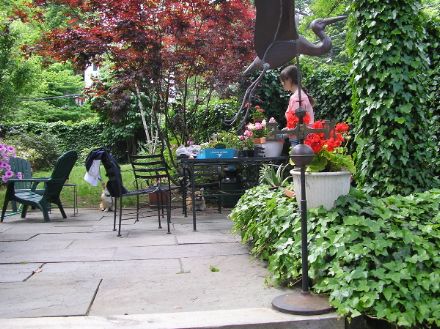
Today was leisurely as well. After dropping in for a chat at the bookshop in town, I called upon the Gills and was finally introduced to Daisy, their latest corgi, purchased during my academic period abroad. Caroline suggested I rest in the hammock while she potted some flowers in the garden, and I happily obliged. Above is the view from the hammock as Caro gives the dogs (behind the chairs) a corrective glance. (more…)
Search
Instagram: @andcusack
Click here for my Instagram photos.Most Recent Posts
- Burns Tower April 19, 2024
- Patrick in Parliament March 18, 2024
- Articles of Note: 13 March 2024 March 13, 2024
- Cambridge March 9, 2024
- Taken on Trust March 4, 2024
Most Recent Comments
Book Wishlist
Monthly Archives
Categories


